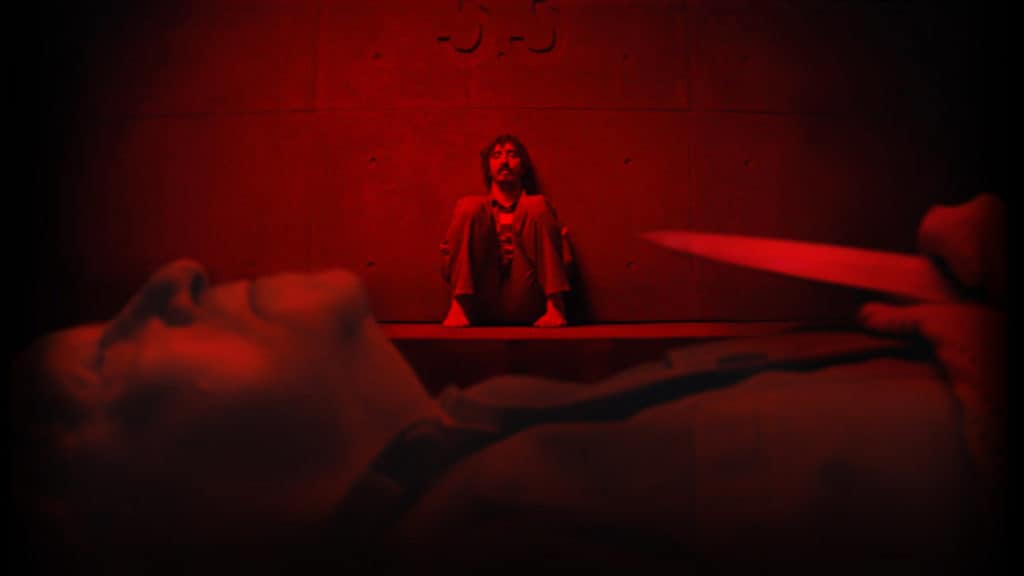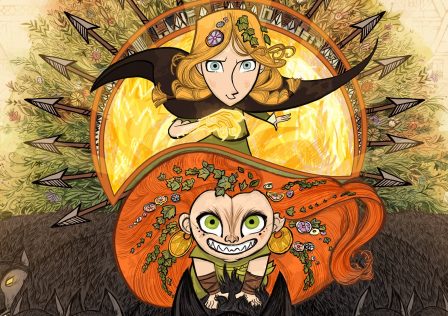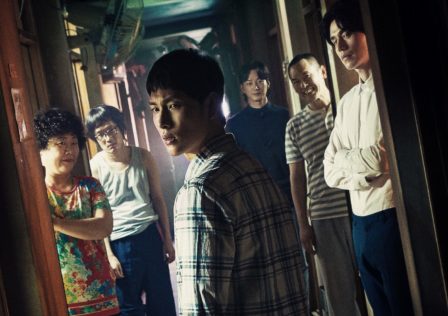Allegories in films have always fascinated me; they are like visual puzzles begging to be solved by the intrepid viewer. The Platform—a Spanish film directed by Galder Gaztelu-Urrutia that is currently a hit on Netflix—is what I would call a near perfect allegory.
I say this because every element in the film—from character to setting to plot—has been distilled to amplify a meaning that transcends the diegesis. The Platform (TP) does not bother with elaborate character set-ups because characters function as archetypes, designed to serve a singular purpose: to advance the fruition of the allegory; fleshing them out too much might detract from the message of the allegory itself.
The film opens with the protagonist Goreng (Ivan Massagué) waking up in what looks like a prison cell on Level 48. His cellmate is a terse and stout old man, and between their beds is a huge rectangle hole. It is through this hole that a lavish daily feast is served, painstakingly laid out on a platform that descends from Level 0 to the floors below. The size of the platform perfectly matches the size of every hole on every level and it stops only for two minutes on each floor, effectively affording every prisoner an exceedingly truncated lunch break.
The food on the platform is not replenished at each floor so inmates on the lower floors eat the leftovers of those above them. As the platform descends the vertical prison, the buffet is reduced to scraps, and eventually, nothing but broken glass and dishware.
If a prisoner were to look down into the hole, he would see an abyss, and around it, the floors below. If he were to accidentally stumble, the hole would swallow him whole (pun intended). In short, this hole is the conduit for sustenance as well as the path to death. It is no accident that the original title for this Spanish film is El Hoyo, translated to mean The Hole.
Goreng shares his cell with three different cell mates during his voluntary incarceration: Trimagasi (Zorion Eguileor), a veteran of the prison system; Imoguiri (Antonia San Juan), a former staff member of the prison management who also volunteered to be imprisoned; and Baharat (Emilio Buale), a religious man who fervently plots to escape the prison. Goreng also has intermittent encounters with the enigmatic Miharu (Alexandra Masangkay), an actress who roams the lock-up, using the moving platform as her mode of transport.
As far as allegories go, The Platform (TP) is a treasure trove of symbols, ranging from the economic to the literary and the biblical.
We learn that Goreng and his fellow captives are kept in a vertical prison comprising 333 levels; each level is akin to a prison cell and each cell holds two prisoners, totalling 666 captives. Being brought up Catholic, it is impossible for me to ignore the obvious numerical associations: the number 666 with the devil or the antichrist, and the number 3 with the holy trinity of God the father, his son Jesus, and the Holy Spirit. But who is the devil and who is the messiah in the film?
As far as allegories go, #Netflix's #ThePlatform is a treasure trove of symbols, ranging from the economic to the literary and the biblical. Tweet this!TP is an allegory about capitalism. On the surface, the connection appears very direct: those at the highest levels are the rich as they are treated to sumptuous meals while those at the lower levels are the poor left with scraps. But the film is actually more complex than that because capitalism is a complicated system with a long history, which the film acknowledges.
Level 0 represents an earlier era of capitalism, namely industrial capitalism. The clue can be found in the opening scene of TP, on a large, bright reddish-brown roller flour mill with a partially visible manufacturer’s imprint: Seck, Dresden (you can see the equipment on Page 19 of this essay by The Mills Archive). Founded by Wilhelm Seck, Messrs Seck Brothers is an important German engineering firm during the industrial revolution, with factories in many cities across Germany, including Dresden. Evidently, the cooks who labour on this highest level are not the ruling elite. Even the dapper head chef decked out in his white suit is still only a cog in the machine.
Levels 1 to 333 represent free market capitalism of the 20th century, an era that saw greater mobility amongst the global workforce. Workers moved to where their jobs took them just as the prisoners in TP exchange levels monthly, with little control over where they end up; migrant workers are now the norm across the globe.
The entire system that maintains the smooth functioning of Levels 0 to 333 is a new and improved beast called late capitalism. In our era of late capitalism, corporations and conglomerates are more powerful than governments. Thousands of their employees do their bidding with no real idea of their impact on human life and the environment, just as the cooks on Level 0 do as they are told with no idea of what’s really going on below them.
Owners of corporations are rarely held accountable because we often don’t even know who they are—ghosts hiding out in private islands reachable by private jets, living off offshore bank accounts that are beyond the reach of law enforcement. In short, the truly powerful and truly rich reap the largesse of a system they prop up with their capital yet are inoculated against its spoils. Similarly, in TP, we have no idea who is really in charge or how the prison system came into being, and I daresay we don’t even wonder. We just assume this is the way things are in the film, as in life, and we go along for the ride.
In my view, this is not a film about the upper classes versus the lower classes; rather, it is a film about the working class: capitalism’s long suffering victims. Incidentally, the prisoners are not the only members of this class; the multi-ethnic crew of young cooks who slaughter, slice, chop and dice at the very top are also workers, decked out in matching uniforms, and doing as they are told.
The biggest visual clue that cements (pun intended) my view is the architectural style of the entire prison complex—a style synonymous with economic austerity, totalitarian governments, and functionalism. With its seemingly endless lengths of exposed concrete walls—monotonous emblems of cost-savings with no interior finishes—and repetitive modular components with a minimalist aesthetic, the prison structure clearly employs the design principles of the Brutalist style. The primary material used by Brutalist architects in the 1950s-1970s is béton brut—French for raw concrete—from which the style derived its name. Unrefined, unpolished, utilitarian—in other words, the working class.
Example of architectures with Brutalist influences
TP‘s prison system is structured such that all its residents enjoy or suffer equally, over time. Its genius lies in two stratagems: first, the prisoners are gassed unconscious each month and when they awake, are mysteriously transported to a seemingly random new level. Secondly, no one is allowed to keep food taken from the platform; if a prisoner breaks this rule, temperature in the room will rise or fall unbearably until the culprit eventually throws his food stash down the hole. These rules ensure that the prisoners never get to maintain or accumulate food, which symbolizes wealth in TP.
Just like the prisoners who rely on the platform to deliver their daily sustenance, the working classes depend on jobs created by capitalist entities to eke out a living, often on daily wages. Yet their ability to save enough money to escape their economic status is thwarted by unexpected upheavals: illness, retrenchment, accidents, etc. Just as the prisoners know not which level they will end up every month, the lives of the working class are also often uncertain, buffeted by the ever fluctuating global financial and political climate.
#Netflix's #ThePlatform is not a film about the upper classes versus the lower classes; rather, it is a film about the working class: capitalism's long suffering victims. Tweet this!Additionally, the monthly jailhouse roulette of level switching has the effect of mentally conditioning the prisoners to stuff their faces when they are at higher levels, to offset hunger if they end up on lower levels later on. Since no-one is allowed to hoard food from the platform, everyone will have the chance to experience starvation and even cannibalism at one point or another during their stint in this perverse penitentiary. In short, the prisoners on the higher floors gorge not only because they can, but because they distinctly remember what it feels like to starve.
In this allegory of capitalism, the hole in the middle functions as a double metaphor: an opportunity as well as an obstacle. The ideology of market capitalism propagates the belief that everyone has the opportunity to move upwards in society if they work hard, but as many of us in reality know, not every opportunity is available to everyone.
To use a contemporary example, when global capital markets fell drastically during the onset of the Covid-19 pandemic, only the rich were able to seize the opportunity to buy up stocks at rock bottom prices. When markets rebound in the foreseeable future, it is also the rich who will reap what they have sown earlier. The working class, on the other hand, has to contend with employment loss or diminished income, and a slew of financial challenges arising from the global recession. The very opportunities grabbed by the rich will present themselves as obstacles for the working class to escape their economic fate.
The capitalist media does a great job of reinforcing the notion that anyone can be rich, even those who are born in the pits of destitution but in reality, very few members of the working class are able to rise to the top without assistance. Baharat knows this full well as he has tried many times to advance to the higher levels in an effort to escape his incarcerated state, with limited success. As there is no incentive for higher-level folks to help those below them, those who do assist, do so out of a sense of charity or benevolence, a quality in limited supply in TP‘s literal dog-eat-dog world.
The film charts the rise and fall of Goreng in this bleak landscape, but we are not tasked to identify and empathize with him or his cellmates, as they are one-dimensional characters with little complexity or nuance. They exist to personify a concept or idea; by figuring out what they represent, we are able to advance our understanding of the allegory they underpin.
The key to deciphering the five main characters lies in the object that every inmate is allowed to bring into the prison.
SPOILERS SMORGASBORD DESCENDING NOW
Trimagasi brings a knife but the Samurai Plus is no ordinary knife; it is a tool that gets sharper with each cut, and Trimagasi is often seen using it to score lines onto the concrete walls of his cell. He needs the knife to be super sharp because when desperation calls, Trimagasi uses it to slice human flesh for food. Thanks to the Samurai Plus, he has survived many a lower level with plenty of meat on his old bones. Trimagasi is unperturbed about what needs to be done to survive; thus he is the embodiment of pragmatism.
Imoguiri brings her pet Dachshund as her companion even though this means an extra mouth to feed. To ensure their joint survival, they take turns eating: Imoguiri, one day and her dog, the next. She also tries to (unsuccessfully) teach other inmates to ration what they eat so that others below them would have some leftovers. Due to her concern for the welfare of others, Imoguiri is the living example of humanitarianism.
Baharat brings a rope, an object with the potential to connect but which also can be fashioned into a noose. But Baharat chooses to use his rope to reach out to others to help him climb up through the hole. In the Old Testament of the Bible, the Hebrew word for rope—chebhel—is also understood to mean, “that which binds” us to God. Since Baharat is a pious man, proudly proclaiming his faith to anyone he meets, he represents religion.
Miharu is probably the most mystifying character of them all. Although disheveled, filthy and dressed in drab prison garb, she is imbued with a provocative presence that invites violence and salacity. Rumours about her abound: she has killed cellmates; she rides the platform in search of her missing child; she desires to be Marilyn Monroe. Her chosen object is a ukelele—the same musical instrument Monroe plays while wantonly singing “Running Wild” in the film Some Like It Hot (1959), a movie that is reputedly “about nothing but sex“. Interestingly, it is Miharu who offers up the Samurai Plus to Goreng, encouraging him to use it on Trimagasi, whose throat she has just slit open. She also feeds Goreng human flesh when he is starving, and she later populates his wet dreams. Miharu is temptation personified.
Goreng brings a book, but not just any book; he totes along the second most translated book after the Bible: Spanish author Miguel de Cervantes’ 1,000 page tome, The Ingenious Nobleman Don Quixote of La Mancha. Don Quixote, by all literary accounts, is a deluded madman, so fixated on his own sense of idealism that he is thoroughly impractical and unrealistic. Hence the term, quixotic, named after Cervantes’ most celebrated fictional character.
Goreng represents idealism. At the start, he tries to hold steadfastly to his principles: he does not grab and gobble food; he rejects cannibalism as a means of survival; he masturbates instead of acting out his lust on Miharu.
But when idealism is bound, gagged and flayed by pragmatism on Level 171, he fights back, stabbing his opponent in a state of unleashed frenzy. After the death of pragmatism, idealism is reminded of a higher purpose when he meets humanitarianism on Level 33. Imoguiri calls Goreng a messiah at this level; coincidentally 33 is also Jesus’ age when he was crucified.
In the final act of the film, idealism joins religion to ensure everyone gets to eat. They do this forcibly, with threats of violence because they know it is almost impossible to reason with inmates long conditioned by the system to only think of themselves. Along the way, they encounter a wheelchair-bound prophet, who teaches them that dialogue is more important than threats. To change the system, they would need to send a clear message to those who run it.
The panna cotta—a fat and sugar rich dessert—is thus chosen for this task. To send back up such a decadent dessert would signal to the powers that be just how much spontaneous solidarity has taken root amongst the prisoners.
But at the end of the day, capitalism is not a system for those who still hold on to their ideals and humanitarianism. Even pragmatists may lose their lives in the name of healthy competition. Temptation is everywhere—just as Miharu appears on every level—cloaked in many guises, even that of a damsel in distress. When Goreng sees Miharu being killed, for example, he loses sight of his mission and tries to avenge her death. Baharat joins the fight to save his friend and both end up mortally wounded. Ultimately, religion is sacrificed at the altar of greed.
Unlike most reviewers who see the girl on Level 333 as a symbol of hope for the future, I have a far bleaker view of the ending. Objectively speaking, idealism, religion, and even pragmatism are dead at the film’s close. Humanitarianism, as we know, killed herself much earlier.
Goreng tells Baharat that the girl is the new message after the latter reluctantly gives up the panna cotta so she could be fed. Yet she eats slowly, not at all like someone who has been starving. Goreng presumes she is Miharu’s child but Miharu entered the prison childless; even if she did give birth in jail, the girl should only be a baby, as Miharu only arrived ten months prior. Based on the logic of the film, such a child should not and could not exist.
It seems that she serves only to make idealism and religion feel better about giving up the message they died for. Furthermore, sending her up on a platform that ascends at such great speeds, which can slice a human body into two, does not bode well for this new message. There is a strong likelihood this message will never arrive intact, if it is understood at all.
At the end of the film, biblical allusions notwithstanding, the devil in this morality tale is capitalism itself— a beast of an economic system so devoid of redemption it cannot be saved by any messiah, living or dead. It is also a beast that can reincarnate into ever more evolved and indefatigable forms of itself. Ultimately, symbols of hope alone are not enough to dismantle a system so robust.
I am pessimistic about the ending because knowing how much capitalism has evolved over the centuries, it is hard to believe that we can take on such a resilient beast and win. It does not mean that all is lost. It just means that there are no simple and straightforward solutions. The harder way—and certainly the more enduring—is to understand the entire system first. Only then would we have a morsel of hope to dismantle it.
Also published on Medium.

C Nge makes it her mission to write about films that have the power to change the world: one heart, one mind at a time.



